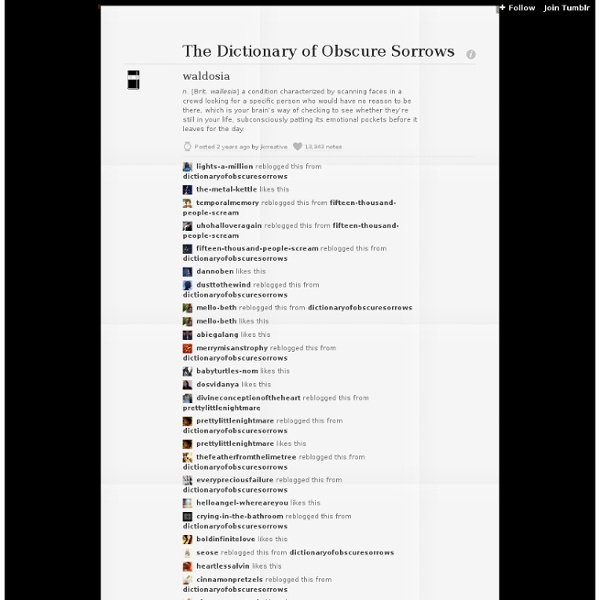Waldosia
The Dictionary of Obscure Sorrows is a compendium of invented words written by John Koenig. Each original definition aims to fill a hole in the language—to give a name to emotions we all might experience but don’t yet have a word for. The author's mission is to capture the aches, demons, vibes, joys and urges that roam the wilderness of the psychological interior. Each sorrow is bagged, tagged and tranquilized, then released gently back into the subconscious. ▸ visit the facebook page to hear the backstory behind each word ▸ follow on twitter (@obscuresorrows) for whatever reason ▸ send me a tumblr message describing emotions you need words for ▸ send me an email via obscuresorrows@gmail.com JOHN KOENIG is a designer and commercial director who lives in St. He is currently writing a book version of The Dictionary of Obscure Sorrows. Copyright © 2013 John Koenig.
Related: Interesting Articles
Belief Systems
By Kanta Jacob Katz Ph.D Guest Writer for Wake Up World Our belief systems are thoughts that have become our habits that determine what we think, what we feel and how we react to life. In our everyday life when we talk about “beliefs” we usually refer to the values we adopt consciously in our life, to our social, political and religious ‘beliefs’ according to which we act and behave. What does all that mean to us? Where does it all come from? Let’s look at these two words together and their meaning, to get a picture of how they interact in our life. The definition of ‘belief’ is: (1) A thought or feeling that something exists or is true, without proof. (2) A vague or specific idea on which some confidence is placed. (3) A religious doctrine that is proclaimed as true. The definition of ‘system’ is: (1) A combination of interrelated interacting elements designed to work as a coherent unit. (2) A group of interrelated elements comprising a unified whole. Do you live in an energy jail?
Jake Reilly's 'Amish Project:' 90 Days Without a Cell Phone, Email and Social Media
Could you live without daily electronic conveniences—Twitter, Facebook, email, texting and more—for 90 days? Jake P. Reilly, a 24-year-old copywriting student at the Chicago Portfolio School, did just that. From October to December, he unplugged from social media, email, texts, and cell phones because he felt that we spend more quality time with gadgets and keyboards than we do with the people we really care about. During his social experiment, he found that some people he counted among his close friends really weren't that close after all. I spoke with Reilly over the phone this weekend about his 90-day project, what he learned from living without electronic leashes and how it changed his life. You say you spent three months completely cut-off from the virtual world. Reilly: I called Verizon and suspended service for my cell phone. Did you ever cheat and check to see what messages came in? Reilly: I never went back on any of the social stuff. Reilly: It was pretty bad. Reilly: Ha!
North Brother Island: Abandoned New York leper colony
Snowbound: The window has fallen out of the wall in this science classroom in the school (left) while tiles cling to a long-abandoned bathtub (right), one of two in the western wing of the tuberculosis pavilion Misplaced: The altarpiece from the chapel was moved to a maintenance building before the island was abandoned where it still sits on a table Mary Mallon (above, right) was the most infamous patient at North Brother Island where she spent nearly three decades of her life. Despite being healthy, she was a carrier of the typhoid virus – and is believed to have been responsible for 43 infections and three deaths. ‘Typhoid’ Mary, an Irish immigrant who emigrated to the U.S. in 1884, worked as a cook from 1900 to 1907. She was first identified as a carrier by medical researcher George Soper, who concluded she was responsible for a spate of infections linked to where she lived and worked. But she refused to listen to him. It was soon a home to six lepers.
Related:



